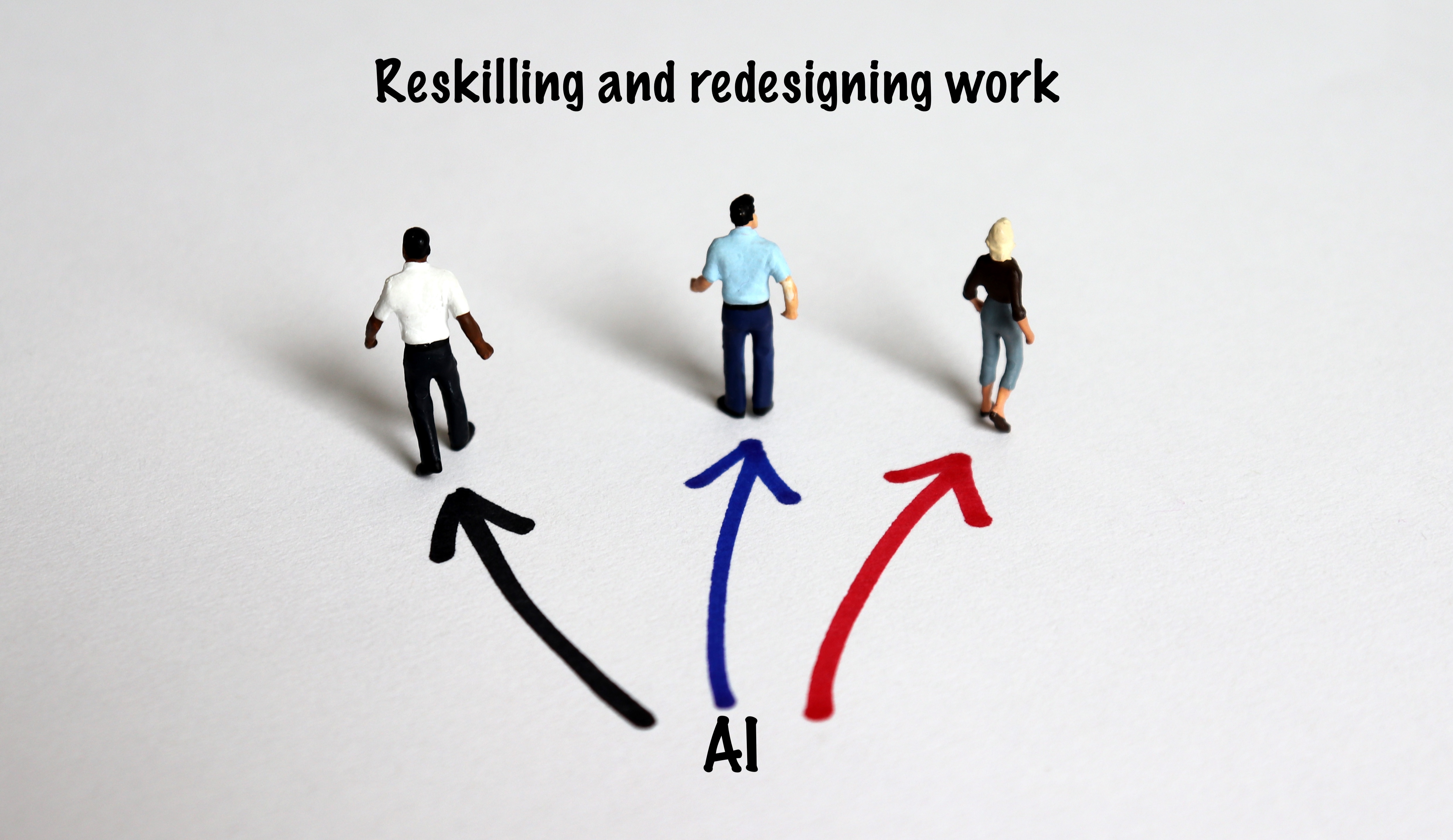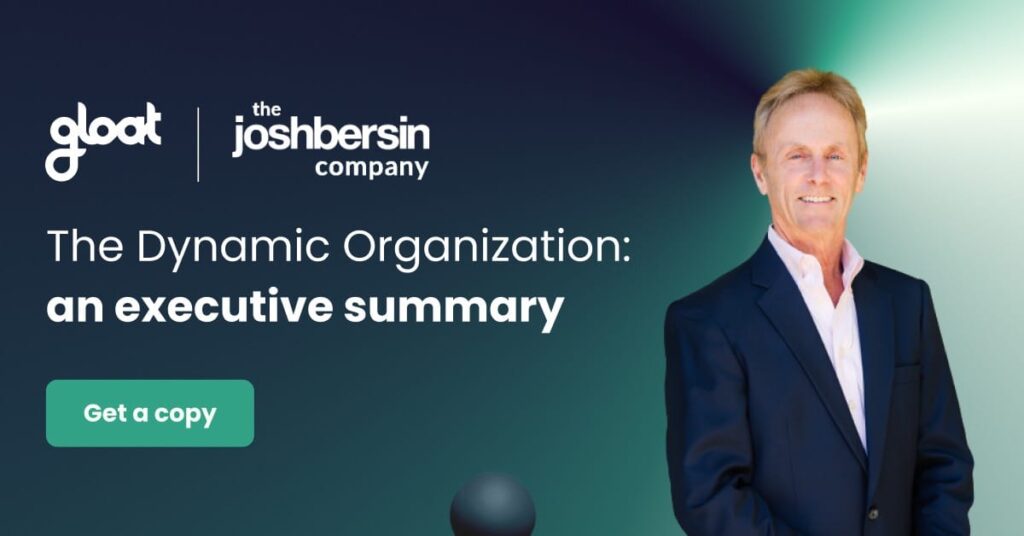Three paths forward in 2024: which way to go?

AI outcomes, and business impact, all run through reskilling and reimagining work
Last year, I wrote an article inspired by one of my favorite quotes from famed New York Yankees baseball player Yogi Berra. He said, “When you come to a fork in the road, take it”. It’s not just good advice for aspiring ball players; it’s something business and HR leaders need to hear as well—perhaps even more so today than when I first shared this quote one year ago.
Back then, ChatGPT was in its infancy and just a few months old. Early adopters began experimenting, and fast, with generative AI, but adoption and business impact were a rarity. Fast forward to today: 97% of executives expect their organizations to be highly impacted by ChatGPT and 62% already use these tools. To put it simply, the question is no longer whether or not we’re entering the age of AI; it’s how will work processes and strategies shift to take advantage of these innovations.
With about 15 months since ChatGPT burst on the scene in late November 2022, there has been a lot written about GenAI, with much more to come. As we’re starting 2024, I want to focus on one critical and central aspect of GenAI. In brief, GenAI’s expected impact on work, jobs, and tasks, will be one of the biggest shifts and disruptions we may see in the span of a few years. The imperative to redesign work (including jobs, projects, and processes) by combining machine and human skills must be front and center. And perhaps the most important challenges will involve the scale and scope of reskilling (that is NEW skills and behaviors) for a huge percentage of work and jobs.
The recent report from the IMF, GenAI: Artificial Intelligence and the Future of Work, estimates that “60% of work and jobs in advanced economies are exposed to the impacts of AI due to the prevalence of cognitive-task-oriented jobs”. As we start 2024, I’ve also been re-reading an article published last March entitled GPTs are GPTs, An Early Look at the Labor Market Impact Potential of Large Language Models. According to the article “Generative Pre-trained Transformers exhibit characteristics of general-purpose technologies (GPTs), suggesting that these models could have notable economic, social, and policy implications.” General-purpose technologies come around infrequently (think steam engines, electricity, and computers) and when they do they have significant impacts on how work is done, the skills and training of the workforce, and implications on geographic strategies.
Ultimately, workforce skills and work redesign are at the heart of this transformation. Even before generative AI went mainstream, visionary leaders were talking about the concept of a skills-based organization: a new model that puts capabilities at the center of work and talent strategies. Organizations will need to embrace skills-centric initiatives to unlock the level of agility that the new world of human-AI teamwork requires. Skills-based strategies enable companies to take stock of the skills they have, identify emerging knowledge gaps, and build the capabilities needed to capitalize on the next wave of AI innovations and adoption.
As business leaders move from experimentation to deployment of GenAI applications, skills-based organizations will be best positioned to leverage these innovations because these companies are designed to grow and adapt. Consequently, leaders can’t afford to hold off on their skills transformations if they’re looking to use AI technologies to their advantage. Instead, they must see this fork in the road for what it is: an opportunity to take stock of workforce skills and implement new tools and strategies to dynamically build current and emerging in-demand capabilities.
Two observations from the recent PwC Global CEO Survey 2024 help summarize the challenge:
- First, 53% of Global CEOs think their current business will not be economically viable in the next 10 years;
- Second, 69% of global CEOs believe that GenAI will require most of their workforce to develop new skills in the next 3 years.
Leaders’ three choices at the intersection of GenAI and skills transformations in 2024
When it comes to defining skills strategies for 2024, most HR leaders are weighing three options. The first is what I call the “wait-and-see” path. It describes executives who are approaching today’s call to action with a “show me”(reactive) mindset. They might see headlines about the impending skills crisis—like the fact that there will be a global human talent shortage of 85 million people by 2030—and recognize that it’s a problem but hold off on taking action. Some might be watching competitors embarking on skills journeys in an effort to learn from their mistakes, while other leaders might mistakenly believe that other items on their agenda outweigh this priority.
The “dip a toe in the water” year is what I consider to be the second option. Leaders who are contemplating this path understand the skills imperative: they recognize that the rise of AI and automation is transforming their workforce and that they must evolve their strategies accordingly. However, these executives are overwhelmed by the idea of embarking on an enterprise-wide skills journey. Instead of researching the tools they’ll need to support skills-centric operating models, they want to start small. So they might launch a new upskilling or reskilling initiative or start a project to map skills to roles. But their hesitancy to explore skills infrastructure technology prevents executives from gaining the strategic workforce planning insights needed to overcome the challenges on the horizon. Ultimately, these middle-of-the-road efforts will likely yield half-baked results.
Finally, the last option is what I call the “lean into the future” path. Leaders who are exploring this direction see the bigger picture and respond accordingly. They recognize that the pace of change is accelerating, the half-life of skills is shrinking, and that AI is transforming every element of our working world. Faced with changes of this magnitude, these executives understand that an equally bold response is our only viable path forward. They’re embracing innovative new technologies to gain complete visibility into workforce skills and AI-powered action platforms like the talent marketplace to efficiently deploy employees to opportunities based on their capabilities and capacities.
Three reasons why embarking on a skills transformation is the path to success in a fast-changing world
Here are three reasons why embracing today’s skills imperative with full force is the only option for leaders who want their organizations to come out on top in the long run for companies preparing for changes including the redesign of work and the adoption of GenAI.
#1. Skill gaps are reaching crisis levels
Skill gaps are nothing new—but their severity is. While businesses may have experienced occasional gaps in knowledge for decades, the discrepancies between the skills employers need and those within their workforce are growing at an alarming rate. Over the past year, 75% of companies have reported difficulty recruiting and acquiring qualified employees and global talent shortages are now at a 16-year high.
There are several factors responsible for these growing skills shortages. In addition to demographic shifts and supply chain disruptions, the rapid pace of technological innovation is also fueling these widening gaps. Advances in AI, robotics, and other emerging technologies are happening in shorter cycles, changing the nature of the jobs that need to be done and the skills required to do them. According to the Organization for Economic Co-operation and Development, as many as 1.1 billion jobs could be transformed by technology over the next decade.
As a result of these severe shortages, companies can no longer rely solely on hiring external talent to acquire the skills their businesses need. Instead, leaders must turn their attention to their existing workforce and develop pathways to help their people upskill and reskill so they’ll be ready to participate in the human-machine collaborations of the future.
#2. Effective skills strategies are proven to improve business growth
As a professor at Columbia Business School, I was thrilled to have the chance to collaborate with The Josh Bersin Company on a study of nearly 800 organizations to identify what differentiates top performers. And what we found is that operating as a skills meritocracy emerged as a commonality among leading companies. Our research analyzes these results, positioning top performers as “Dynamic Organizations.”
Key to being “Dynamic”, a skills meritocracy describes an egalitarian approach to talent mobility that’s rooted in the skills employees possess and how they align with the capabilities required to complete a project or role. Rather than relying on pedigree or seniority to dictate which people should fill specific positions, skills meritocracies use employees’ capabilities to determine career progression, promotions, and pay.
Based on the study, using skills insights to drive strategic decisions tripled the likelihood that an organization would hit its financial targets, and made it five times more likely that an organization achieved higher productivity levels. “In order to become Dynamic, you have to be willing to move people around,” Bersin explains. “You’ve got to respect that they might have the skills but maybe they’re young or they haven’t worked in the domain before. If you don’t have a skills meritocracy, then you end up with these silos and that’s a very traditional way of thinking that holds many companies back.”
#3. Pioneering organizations have already shown a skills-based framework is effective—and they’re reaping the benefits
There are already vanguard companies that are taking a future-forward approach by accelerating their skills transformations—and the results speak for themselves. Novartis is one enterprise that exemplifies what it means to become a skills-based organization. The leading pharmaceutical company transitioned to skills-based operating models to equip its workforce with the skills needed to stay at the forefront of medical innovations. To gain a complete picture of their workforce capabilities and emerging learning priorities, Novartis uses a skills intelligence tool to harmonize data across disparate systems, in turn enabling the organization to create a unified job architecture.
In describing how their skills infrastructure technology equips leaders with complete visibility into workforce capabilities and skills needs, Novartis’s Global Head of Talent Markus Graf says, “We’re exploring…how we can use skills to gain a deeper understanding of our organization. Instead of functional clusters, there would be workforce and capability clusters, viewing people in terms of the skills they possess. We now have the data and capacity to utilize it in such a manner, and it’s a really powerful approach.” By viewing their people in terms of the skills they have, leaders at Novartis will be able to identify employees with the competencies needed to embark on ambitious collaborations between humans and AI. And, as new jobs emerge in our new age of AI, Novartis’s unified job architecture will ensure the organization gains insight into trending roles and the skills needed to fulfill them.
HSBC is another company at the forefront of dynamic skills transformations. By leveraging skills intelligence, the organization has gained insight into the capabilities that will become increasingly in demand as AI use cases continue to gain traction. Hamish Nesbit, former Group Head of Resourcing at HSBC, describes the Bank’s transformation in the following words: “The idea that we now know with greater certainty, what skills sit where and what aims people have gives us a much stronger platform to think about increasing our internal mobility, which in turn retains our global corporate knowledge and builds employee engagement as they start to understand that more and more of their goals and ambitions can be realized within HSBC.”
So, much like last year, I encourage leaders to listen to Yogi Berra’s advice and take the fork in the road. The choices are clear: wait and see, test the water, or fully embrace the skills-based approach that differentiates today’s top-performing companies when preparing for the future which is being shaped by multiple forces, including, of course, GenAI. If you’re ready to join leading organizations like Novartis and HSBC and turn 2024 into the year that your organization embarks on a game-changing skills transformation journey, download The Dynamic Organization research we’ve collaborated with The Josh Bersin Company to publish.






